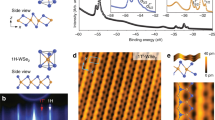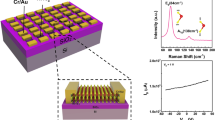Abstract
Recently, the layered transition metal dichalcogenide 1T′-MoTe2 has generated considerable interest due to their superconducting and non-trivial topological properties. Here, we present a systematic study on 1T′-MoTe2 single-crystal and exfoliated thin-flakes by means of electrical transport, scanning tunnelling microscope (STM) measurements and band structure calculations. For a bulk sample, it exhibits large magneto-resistance (MR) and Shubnikov–de Hass oscillations in ρxx and a series of Hall plateaus in ρxy at low temperatures. Meanwhile, the MoTe2 thin films were intensively investigated with thickness dependence. For samples, without encapsulation, an apparent transition from the intrinsic metallic to insulating state is observed by reducing thickness. In such thin films, we also observed a suppression of the MR and weak anti-localization (WAL) effects. We attributed these effects to disorders originated from the extrinsic surface chemical reaction, which is consistent with the density functional theory (DFT) calculations and in-situ STM results. In contrast to samples without encapsulated protection, we discovered an interesting superconducting transition for those samples with hexagonal Boron Nitride (h-BN) film protection. Our results indicate that the metallic or superconducting behavior is its intrinsic state, and the insulating behavior is likely caused by surface oxidation in few layer 1T’-MoTe2 flakes.
Similar content being viewed by others
References
J. A. Wilson and A. D. Yoffe, The transition metal dichalcogenides discussion and interpretation of the observed optical, electrical and structural properties, Adv. Phys. 18(73), 193 (1969)
R. C. Morris, R. V. Coleman, and R. Bhandari, Superconductivity and magnetoresistance in NbSe2, Phys. Rev. B 5(3), 895 (1972)
M. Chhowalla, H. S. Shin, G. Eda, L. J. Li, K. P. Loh, and H. Zhang, The chemistry of two-dimensional layered transition metal dichalcogenide nanosheets, Nat. Chem. 5(4), 263 (2013)
B. Radisavljevic, A. Radenovic, J. Brivio, V. Giacometti, and A. Kis, Single-layer MoS2 transistors, Nat. Nanotechnol. 6(3), 147 (2011)
R. A. Klemm, Pristine and intercalated transition metal dichalcogenide superconductors, Physica C 514, 86 (2015)
X. Qian, J. Liu, L. Fu, and J. Li, Quantum spin Hall effect in two-dimensional transition metal dichalcogenides, Science 346(6215), 1344 (2014)
K. Novoselov, D. V. Andreeva, W. Ren, and G. Shan, Graphene and other two-dimensional materials, Front. Phys. 14(1), 13301 (2019)
J. Qi, H. Liu, H. Jiang, and X. C. Xie, Dephasing effects in topological insulators, Front. Phys. 14(4), 43403 (2019)
T. Teshome and A. Datta, Topological insulator in two-dimensional SiGe induced by biaxial tensile strain, ACS Omega 3(1), 1 (2018)
Q. Liu, X. Zhang, L. B. Abdalla, A. Fazzio, and A. Zunger, Switching a normal insulator into a topological insulator via electronic field with application to phosphorene, Nano Lett. 15(2), 1222 (2015)
A. K. Geim and I. V. Grigorieva, Van der Waals heterostructures, Nature 499(7459), 419 (2013)
Y. Qi, P. G. Naumov, M. N. Ali, C. R. Rajamathi, W. Schnelle, O. Barkalov, M. Hanfland, S. C. Wu, C. Shekhar, Y. Sun, V. Süß, M. Schmidt, U. Schwarz, E. Pippel, P. Werner, R. Hillebrand, T. Förster, E. Kampert, S. Parkin, R. J. Cava, C. Felser, B. Yan, and S. A. Medvedev, Superconductivity in Weyl semimetal candidate MoTe2, Nat. Commun. 7(1), 11038 (2016)
Q. Zhou, D. Rhodes, Q. R. Zhang, S. Tang, R. Schönemann, and L. Balicas, Hall effect within the colossal magnetoresistive semimetallic state of MoTe2, Phys. Rev. B 94(12), 121101 (2016)
D. H. Keum, S. Cho, J. H. Kim, D. H. Choe, H. J. Sung, M. Kan, H. Kang, J. Y. Hwang, S. W. Kim, H. Yang, K. J. Chang, and Y. H. Lee, Bandgap opening in fewlayered monoclinic MoTe2, Nat. Phys. 11(6), 482 (2015)
H. P. Hughes and R. H. Friend, Electrical resistivity anomaly in b-MoTe2 (metallic behavior), J. Phys. C Solid State Phys. 11(3), L103 (1978)
T. Zandt, H. Dwelk, C. Janowitz, and R. Manzke, Quadratic temperature dependence up to 50 K of the resistivity of metallic MoTe2, J. Alloys Compd. 442L103(1–2), 216 (2007)
Y. Sun, S. C. Wu, M. N. Ali, C. Felser, and B. Yan, Prediction of Weyl semimetal in orthorhombic MoTe2, Phys. Rev. B 92(16), 161107 (2015)
R. Szczsniak, A. P. Durajski, and M. W. Jarosik, Strong-coupling superconductivity induced by calcium intercalation in bilayer transition-metal dichalcogenides, Front. Phys. 13(2), 137401 (2018)
J. Cui, P. Li, J. Zhou, W. Y. He, X. Huang, J. Yi, J. Fan, Z. Ji, X. Jing, F. Qu, Z. G. Cheng, C. Yang, L. Lu, K. Suenaga, J. Liu, K. T. Law, J. Lin, Z. Liu, and G. Liu, Transport evidence of asymmetric spin-orbit coupling in fewlayer superconducting 1Td-MoTe2, Nat. Commun. 10(1), 2044 (2019)
Y. Gan, C.W. Cho, A. Li, J. Lyu, X. Du, J. S. Wen, and L. Y. Zhang, Giant enhancement of superconductivity in few layers MoTe2, Chin. Phys. B 28(11), 117401 (2019)
L. Yang, H. Wu, W. Zhang, Z. Chen, J. Li, X. Lou, Z. Xie, R. Zhu, and H. Chang, Anomalous oxidation and its effect on electrical transport originating from surface chemical instability in large-area, few-layer 1T’-MoTe2 films, Nanoscale 10(42), 19906 (2018)
F. Ye, J. Lee, J. Hu, Z. Mao, J. Wei, and P. X. L. Feng, Environmental instability and degradation of single- and few-layer WTe2 nanosheets in ambient conditions, Small 12(42), 5802 (2016)
B. Chen, H. Sahin, A. Suslu, L. Ding, M. I. Bertoni, F. M. Peeters, and S. Tongay, Environmental changes in MoTe2 excitonic dynamics by defects-activated molecular interaction, ACS Nano 9(5), 5326 (2015)
H. Zhu, Q. Wang, L. Cheng, R. Addou, J. Kim, M. J. Kim, and R. M. Wallace, Defects and surface structural stability of MoTe2 under vacuum annealing, ACS Nano 11(11), 11005 (2017)
J. M. Woods, J. Shen, P. Kumaravadivel, Y. Pang, Y. Xie, G. A. Pan, M. Li, E. I. Altman, L. Lu, and J. J. Cha, Suppression of magnetoresistance in thin WTe2 flakes by surface oxidation, ACS Appl. Mater. Interfaces 9(27), 23175 (2017)
D. Rhodes, R. Schönemann, N. Aryal, Q. Zhou, Q. R. Zhang, E. Kampert, Y.C. Chiu, Y. Lai, Y. Shimura, G. T. McCandless, J. Y. Chan, D. W. Paley, J. Lee, A. D. Finke, J. P. C. Ruff, S. Das, E. Manousakis, and L. Balicas, Bulk Fermi surface of the Weyl type-II semimetallic candidate g-MoTe2, Phys. Rev. B 96(16), 165134 (2017)
I. Childres, L. A. Jauregui, J. Tian, and Y. P. Chen, Effect of oxygen plasma etching on graphene studied using Raman spectroscopy and electronic transport measurements, New J. Phys. 13(2), 025008 (2011)
B. Zhao, P. Cheng, H. Pan, S. Zhang, B. Wang, G. Wang, F. Xiu, and F. Song, Weak antilocalization in Cd3As2 thin films, Sci. Rep. 6(1), 22377 (2016)
N. P. Breznay, H. Volker, A. Palevski, R. Mazzarello, A. Kapitulnik, and M. Wuttig, Weak antilocalization and disorder-enhanced electron interactions in annealed films of the phase-change compound GeSb2Te4, Phys. Rev. B 86(20), 205302 (2012)
Y. Wu, N. H. Jo, M. Ochi, L. Huang, D. Mou, S. L. Bud’ko, P. C. Canfield, N. Trivedi, R. Arita, and A. Kaminski, Temperature-induced Lifshitz transition in WTe2, Phys. Rev. Lett. 115(16), 166602 (2015)
S. Hikami, A. I. Larkin, and Y. Nagaoka, Spin–orbit interaction and magnetoresistance in the two dimensional random system, Prog. Theor. Phys. 63(2), 707 (1980)
G. Bergmann, Weak localization in thin films: A timeofflight experiment with conduction electrons, Phys. Rep. 107(1), 1 (1984)
J. Chen, H. J. Qin, F. Yang, J. Liu, T. Guan, F. M. Qu, G. H. Zhang, J. R. Shi, X. C. Xie, C. L. Yang, K. H. Wu, Y. Q. Li, and L. Lu, Gate-voltage control of chemical potential and weak antilocalization in Bi2Se3, Phys. Rev. Lett. 105(17), 176602 (2010)
H. T. He, G. Wang, T. Zhang, I. K. Sou, G. K. L. Wong, J. N. Wang, H. Z. Lu, S. Q. Shen, and F. C. Zhang, Impurity effect on weak antilocalization in the topological insulator Bi2Te3, Phys. Rev. Lett. 106(16), 166805 (2011)
J. J. Cha, D. Kong, S. S. Hong, J. G. Analytis, K. Lai, and Y. Cui, Weak antilocalization in Bi2(SexTe1-x)3 nanoribbons and nanoplates, Nano Lett. 12(2), 1107 (2012)
S. Matsuo, T. Koyama, K. Shimamura, T. Arakawa, Y. Nishihara, D. Chiba, K. Kobayashi, T. Ono, C. Z. Chang, K. He, X. C. Ma, and Q. K. Xue, Weak antilocalization and conductance fluctuation in a submicrometersized wire of epitaxial Bi2Se3, Phys. Rev. B 85(7), 075440 (2012)
H. Steinberg, J. B. Laloë, V. Fatemi, J. S. Moodera, and P. Jarillo-Herrero, Electrical tunable surface-to-bulk coherent coupling in topological insulator thin films, Phys. Rev. B 84(23), 233101 (2011)
G. Kresse and J. Hafner, ab initio molecular-dynamics simulation of the liquid-metal-amorphous-semiconductor transition in germanium, Phys. Rev. B 49(20), 14251 (1994)
G. Kresse and J. Furthmüller, Efficient iterative schemes for ab initio total-energy calculations using a plane-wave basis set, Phys. Rev. B 54(16), 11169 (1996)
P. E. Blöchl, Projector augmented-wave method, Phys. Rev. B 50(24), 17953 (1994)
J. P. Perdew, K. Burke, and M. Ernzerhof, Generalized gradient approximation made simple, Phys. Rev. Lett. 77(18), 3865 (1996)
J. Heyd, G. E. Scuseria, and M. Ernzerhof, Hybrid functionals based on a screened coulomb potential, J. Chem. Phys. 118(18), 8207 (2003)
Acknowledgements
The work was supported by the Guangdong Innovative and Entrepreneurial Research Team Program, China (Grant No. 2016ZT06D348), the National Natural Science Foundation of China (Grant No. 11874193), and the Shenzhen Fundamental Subject Research Program, China (Grant No. JCYJ20170817110751776). K. D. W. acknowledges support from the National Natural Science Foundation of China (Grant No. 11574128). X. D. acknowledges support from NSF under award DMR-1808491.
Author information
Authors and Affiliations
Corresponding author
Rights and permissions
About this article
Cite this article
Gan, Y., Liang, J., Cho, Cw. et al. Bandgap opening in MoTe2 thin flakes induced by surface oxidation. Front. Phys. 15, 33602 (2020). https://doi.org/10.1007/s11467-020-0952-x
Received:
Accepted:
Published:
DOI: https://doi.org/10.1007/s11467-020-0952-x




